White flowers with black centers are an exquisite addition to any garden. They are visually striking and unique, adding a touch of elegance and drama to any landscape. White flowers with black centers are available in a variety of shapes and sizes, making them a versatile choice for any garden style.
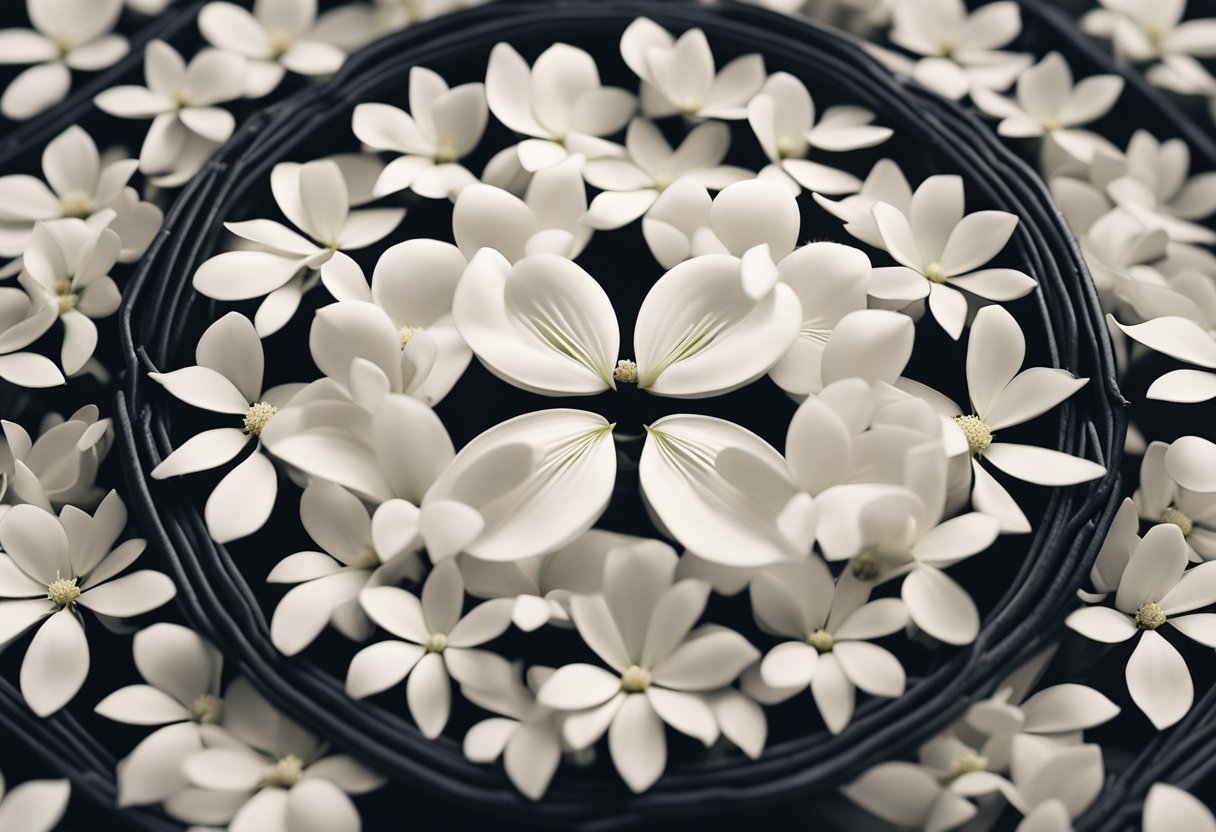
Some popular varieties of white flowers with black centers include Petunias, Anemones, and Foxgloves. Petunias are known for their ruffled blooms, characterized by pristine white petals encircling a dramatic black core. Anemones, on the other hand, have bright flowers that appear similar to poppies, with a dark circular center bursting against white petals. Foxgloves produce spikes of bell-shaped blooms in shades of pink, purple, and white, with dark centers adding to their stunning looks.
Key Takeaways
- White flowers with black centers are a visually striking addition to any garden.
- Popular varieties of white flowers with black centers include Petunias, Anemones, and Foxgloves.
- White flowers with black centers are available in a variety of shapes and sizes, making them a versatile choice for any garden style.
Anatomy of White Flowers with Black Centers
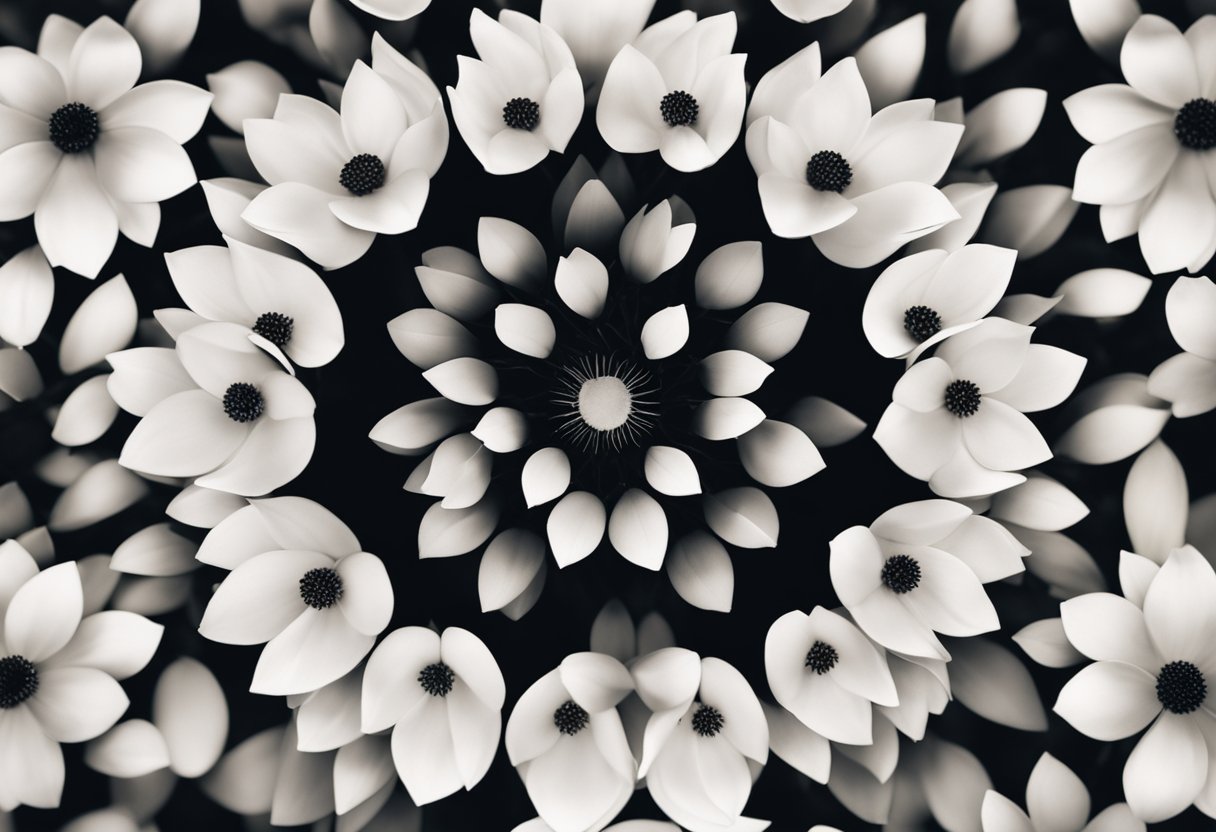
White flowers with black centers are unique and captivating in their own way. They add an element of drama and contrast to any garden or floral arrangement. In this section, I will discuss the anatomy of these flowers, including their petal structure and reproductive organs.
Petal Structure
The petals of white flowers with black centers are usually white or cream-colored, with a striking black or dark center. The petals can be ruffled, frilly, or smooth, depending on the species. These petals are usually thin and delicate, and they come in various shapes, including round, oval, and heart-shaped.
Reproductive Organs
The reproductive organs of white flowers with black centers are the stamen and the pistil. The stamen is the male reproductive organ, and it consists of the anther and the filament. The anther produces pollen, which is transferred to the pistil during pollination. The pistil is the female reproductive organ, and it consists of the stigma, the style, and the ovary. The stigma is the part of the pistil that receives the pollen, and the style is the tube that connects the stigma to the ovary. The ovary contains the ovules, which are fertilized by the pollen to produce seeds.
White flowers with black centers are unique and captivating in their own way. Their petal structure and reproductive organs are similar to those of other flowers, but their striking contrast makes them stand out. Understanding the anatomy of these flowers can help you appreciate their beauty even more.
Popular Varieties of White Flowers with Black Centers
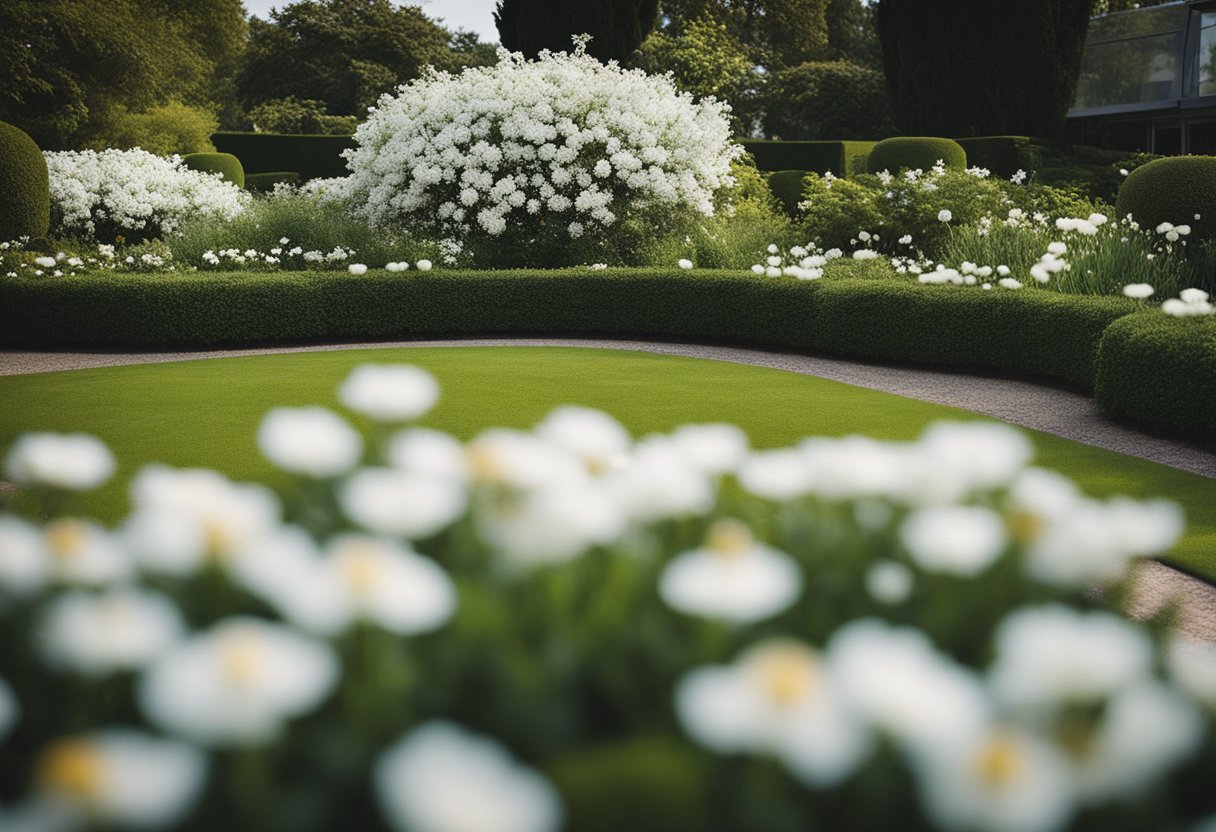
As a botanist, I have come across several white flowers with black centers that are popular among gardeners. Here are some of the most sought-after varieties:
Anemone De Caen
Anemone De Caen is a beautiful white flower with a black center that blooms in early spring. Its large, showy flowers have a delicate, papery texture and a lovely fragrance. They are perfect for adding a touch of elegance to any garden. Anemone De Caen is easy to grow and requires minimal care. It thrives in well-drained soil and partial shade.
Osteospermum
Osteospermum, also known as the African Daisy, is a stunning white flower with a black center that blooms in late spring and early summer. Its daisy-like flowers come in a range of colors, including white, pink, purple, and yellow. Osteospermum is a hardy plant that requires full sun and well-drained soil. It is also drought tolerant, making it an excellent choice for low-maintenance gardens.
White Sandersonia
White Sandersonia is a beautiful white flower with a black center that blooms in mid-summer. Its delicate, bell-shaped flowers have a sweet, fruity fragrance and are perfect for adding a touch of romance to any garden. White Sandersonia is easy to grow and requires partial shade and well-drained soil.
Panda Anemone
Panda Anemone is a stunning white flower with a black center that blooms in mid-spring. Its large, showy flowers have a unique, panda-like appearance and are perfect for adding a touch of whimsy to any garden. Panda Anemone is easy to grow and requires full sun and well-drained soil.
These are just a few popular varieties of white flowers with black centers that are sure to add a touch of elegance, romance, and whimsy to any garden. With minimal care and the right growing conditions, these stunning flowers are sure to thrive and delight gardeners for years to come.
Cultivation Tips for White Flowers with Black Centers
Soil Requirements
As a general rule, white flowers with black centers prefer well-draining soil that is rich in organic matter. Soil that is too compact can make it difficult for the roots to grow and absorb nutrients. Adding compost or other organic matter to the soil can help improve drainage and provide the necessary nutrients for healthy growth. It is also important to ensure that the soil pH is within the ideal range for the specific plant species.
Sunlight and Watering
Most white flowers with black centers prefer full sun exposure, although some species can tolerate partial shade. It is important to ensure that the plants receive adequate sunlight, as too little can result in weak growth and poor flowering. Adequate watering is also essential, as these plants require consistent moisture to thrive. However, overwatering can lead to root rot and other fungal diseases, so it is important to strike a balance between too much and too little water.
Fertilization
White flowers with black centers can benefit from regular fertilization, as this can help promote healthy growth and flowering. However, it is important to choose a fertilizer that is appropriate for the specific plant species, as different plants have different nutrient requirements. Over-fertilization can also be harmful, so it is important to follow the manufacturer’s instructions carefully and avoid applying too much fertilizer. In general, it is best to fertilize these plants during the growing season, and to avoid fertilizing during periods of dormancy.
Also Read | 10 Stunning Varieties of Vine Plant With Purple Flowers
Symbolism and Meaning
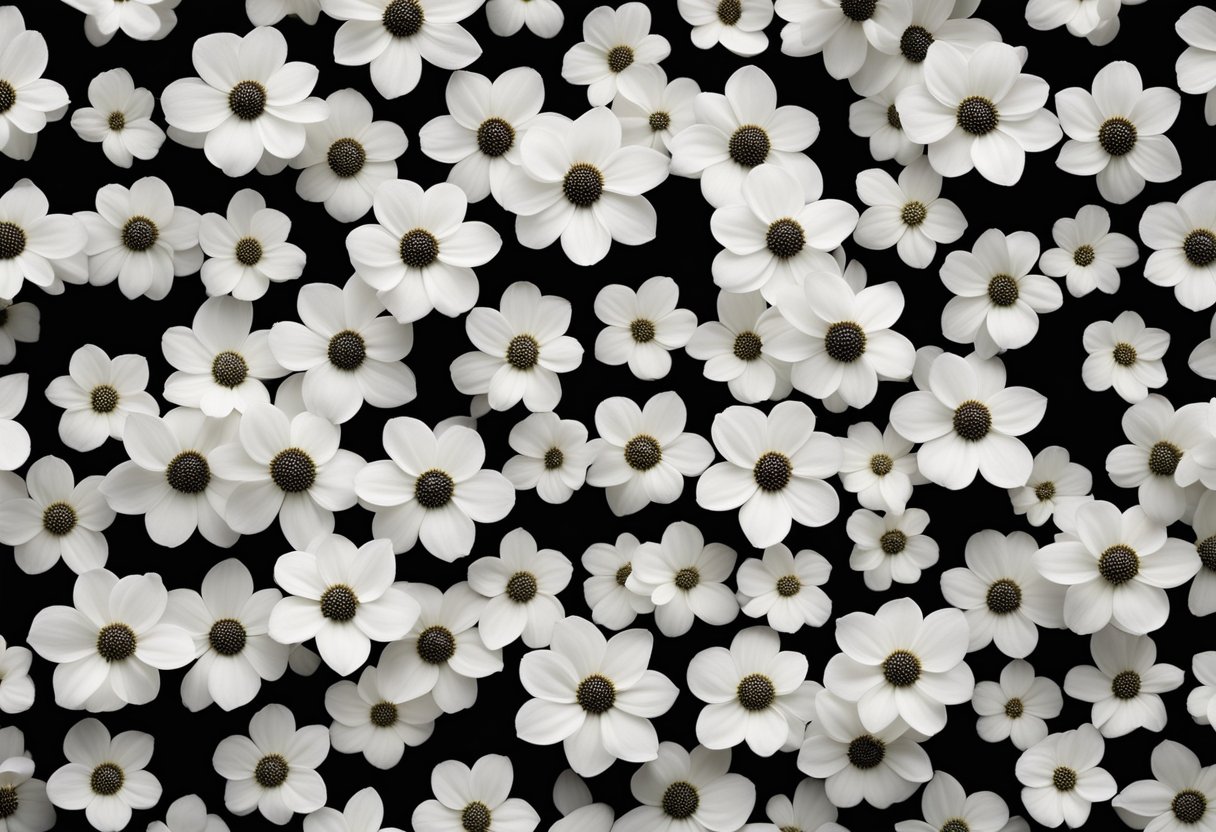
Cultural Significance
White flowers with black centers have been used in various cultures to symbolize different meanings. In some cultures, they are seen as a symbol of hope and resilience in the face of adversity. The black center represents the difficulties that we all face in life, while the white petals represent the hope and resilience that helps us overcome them.
In other cultures, white flowers with black centers are seen as a symbol of purity and innocence. The black center represents the darkness that surrounds us, while the white petals represent the purity and innocence that we strive to maintain.
Occasions and Use
White flowers with black centers are often used in weddings and other special occasions to symbolize purity, innocence, and hope. They can be used as a centerpiece or as part of a bridal bouquet.
These flowers are also used in funerals and other somber occasions to symbolize the hope and resilience that we have in the face of death and loss. They can be used as part of a funeral arrangement or as a gift to someone who is grieving.
Here are some of the occasions and uses of white flowers with black centers:
- Weddings: White flowers with black centers can be used as a centerpiece or as part of a bridal bouquet to symbolize purity, innocence, and hope.
- Funerals: White flowers with black centers can be used as part of a funeral arrangement or as a gift to someone who is grieving to symbolize the hope and resilience that we have in the face of death and loss.
- Gift-giving: White flowers with black centers can be given as a gift to someone who needs a reminder of hope and resilience in their life. They can also be given as a symbol of purity and innocence.
White flowers with black centers are a powerful symbol of hope, resilience, purity, and innocence. They can be used in a variety of occasions and settings to convey these meanings and to provide comfort and solace to those who need it.
Landscaping with White and Black Flowers
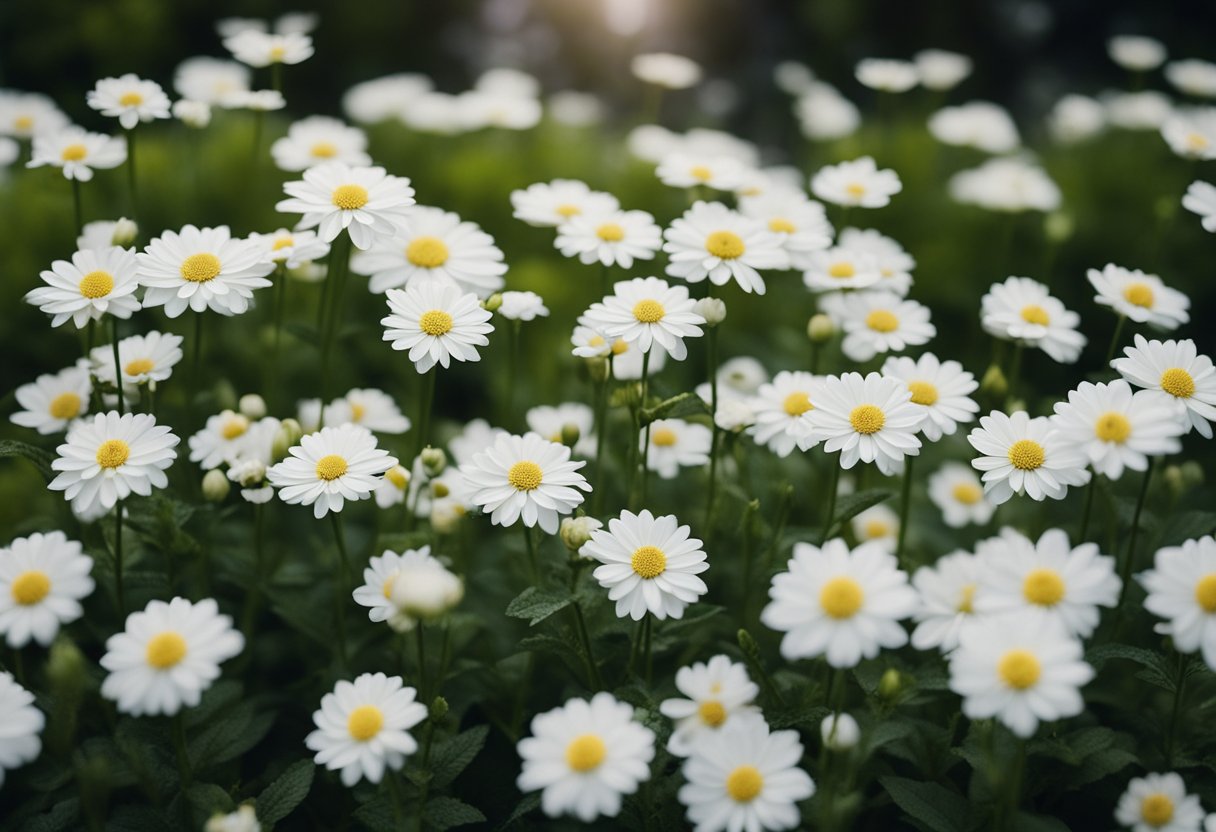
As a landscape designer, I always recommend incorporating white and black flowers in garden designs. These colors add a touch of sophistication and elegance to any landscape. In this section, I will discuss some design principles and companion planting ideas for white and black flowers.
Design Principles
When designing a garden with white and black flowers, it is important to consider the following principles:
- Contrast: The contrast between white and black creates a dramatic effect in the garden. By planting white flowers with black centers, you can create a stunning focal point that draws the eye.
- Balance: Balance is key in any garden design. When using white and black flowers, it is important to ensure that they are distributed evenly throughout the garden to create a balanced look.
- Texture: Texture is an important element in garden design. By incorporating flowers with different textures, such as fluffy white daisies and sleek black-eyed susans, you can create a visually interesting landscape.
Companion Planting
White and black flowers can be paired with a variety of other plants to create a stunning garden. Here are some companion planting ideas:
- White flowers with black centers, such as petunias and lilies, look great when paired with green foliage plants, such as hostas and ferns. The green foliage provides a neutral backdrop that allows the white and black flowers to stand out.
- Black flowers, such as black pansies and black dahlias, look great when paired with white flowers, such as white impatiens and white daisies. This creates a striking contrast that is sure to catch the eye.
- White and black flowers can also be paired with other colors to create a colorful garden. For example, white and black flowers look great when paired with yellow or pink flowers.
White and black flowers are a great addition to any garden design. By following the design principles and companion planting ideas outlined above, you can create a stunning landscape that is sure to impress.
Pests and Diseases
Common Pests
When it comes to white flowers with black centers, they can be susceptible to a variety of pests. Aphids, spider mites, and thrips are common pests that can infest these plants. Aphids are small, soft-bodied insects that can be found on the underside of leaves and stems. They suck the sap out of the plant and can cause yellowing and curling of leaves. Spider mites are tiny, spider-like creatures that can spin webs on leaves. They also suck the sap out of the plant and can cause leaves to turn yellow and fall off. Thrips are small, slender insects that feed on the flowers and leaves of plants. They can cause leaves to become distorted and discolored.
Disease Management
White flowers with black centers can also be prone to certain diseases. Powdery mildew is a common fungal disease that can affect these plants. It appears as a white, powdery coating on the leaves and stems. To prevent powdery mildew, it is important to plant in well-drained soil and avoid overhead watering. Another disease that can affect these plants is Pyracantha diseases. These diseases can cause leaf spots, cankers, and twig blight. To prevent Pyracantha diseases, it is important to plant in well-drained soil and avoid overcrowding. It is also important to prune infected branches and dispose of them properly.
In addition to these pests and diseases, it is important to keep an eye out for any signs of stress or damage on your white flowers with black centers. Regular inspections and proper care can help keep your plants healthy and thriving.
Propagation Methods
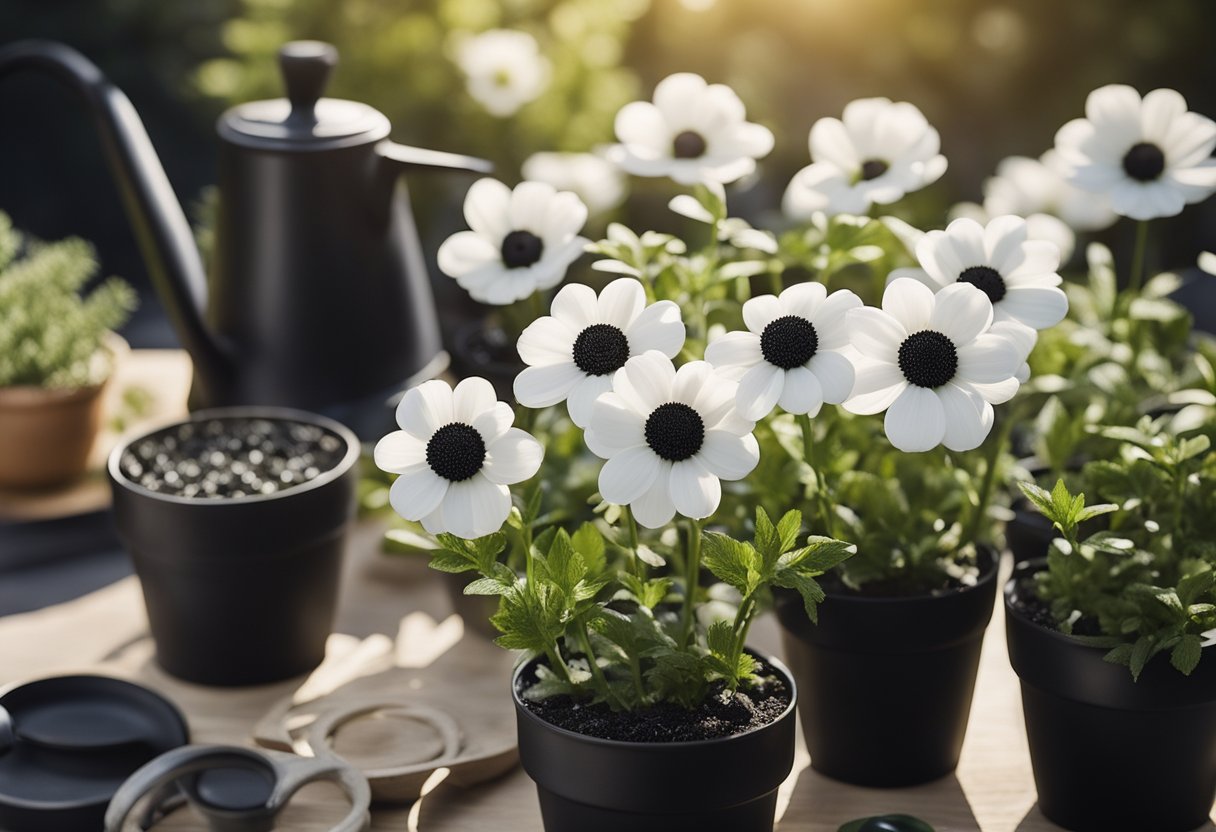
When it comes to growing white flowers with black centers, there are two main propagation methods that I recommend: seed starting and cuttings.
Seed Starting
Seed starting is a common and straightforward method of propagation. Collecting and sowing seeds allows for the reproduction of flower varieties true to the parent plant or potential hybridization if different varieties are cross-pollinated.
To start seeds, you’ll need to first gather the seeds from the flowers. Once you have the seeds, you can start them indoors in a seed tray or directly sow them in the garden. If starting indoors, make sure to use a high-quality seed starting mix and keep the soil consistently moist. Once the seedlings have grown large enough, you can transplant them to their final location in the garden.
Cuttings
Another way to propagate white flowers with black centers is through cuttings. This method involves taking a cutting from the parent plant and rooting it to create a new plant.
To take a cutting, choose a healthy stem from the parent plant and cut it just below a leaf node. Remove the leaves from the bottom half of the stem and dip the cut end in rooting hormone. Plant the cutting in a pot filled with a well-draining potting mix and keep the soil consistently moist. Once the cutting has rooted, you can transplant it to its final location in the garden.
Both seed starting and cuttings are effective methods of propagating white flowers with black centers. Choose the method that works best for you and enjoy the beauty of these stunning flowers in your garden.
Seasonal Care
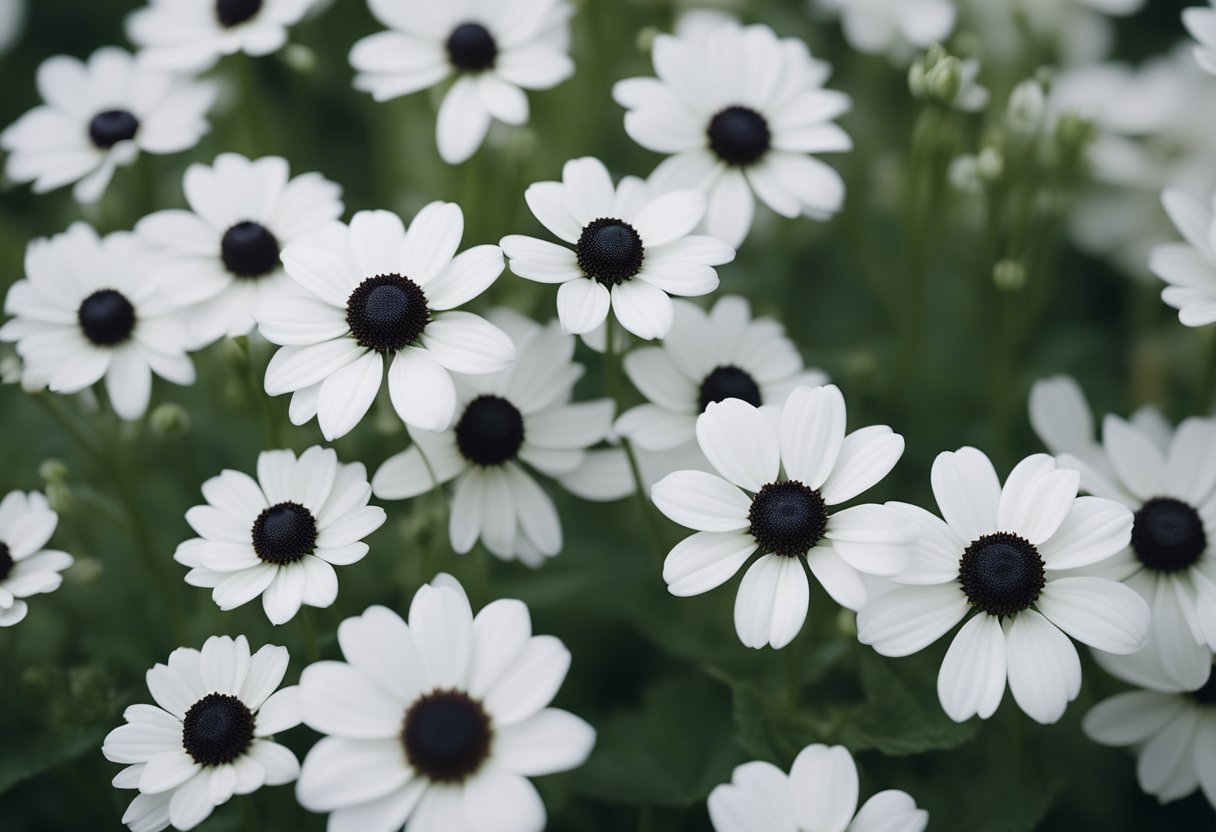
Spring Care
During the spring season, it is important to prepare your white flowers with black center for the warmer months ahead. This includes checking the soil for moisture levels, removing any dead or damaged foliage, and applying a slow-release fertilizer to promote healthy growth. It is also recommended to keep an eye out for pests, such as aphids and spider mites, which can damage the leaves and flowers.
Summer Care
In the summer months, it is crucial to keep your white flowers with black center well-hydrated, as they may require more water due to the heat. It is also important to deadhead spent blooms regularly to encourage new growth and prevent disease. Additionally, providing shade during the hottest parts of the day can help prevent wilting and sun damage.
Autumn Care
As the temperatures begin to cool down, it is important to prepare your white flowers with black center for the upcoming winter months. This includes cutting back any dead foliage, removing any weeds, and mulching around the base of the plant to protect the roots from frost. It is also recommended to reduce watering to avoid over-saturating the soil.
Winter Care
During the winter season, it is important to protect your white flowers with black center from freezing temperatures and frost damage. This can be done by covering the plant with a frost cloth or burlap, or by moving the plant indoors to a location with adequate sunlight and warmth. It is also important to avoid overwatering during this time, as the plant may not be actively growing and can become waterlogged.
Providing proper seasonal care for your white flowers with black center can help ensure their health and longevity, and keep them looking beautiful year-round.
Conservation Status
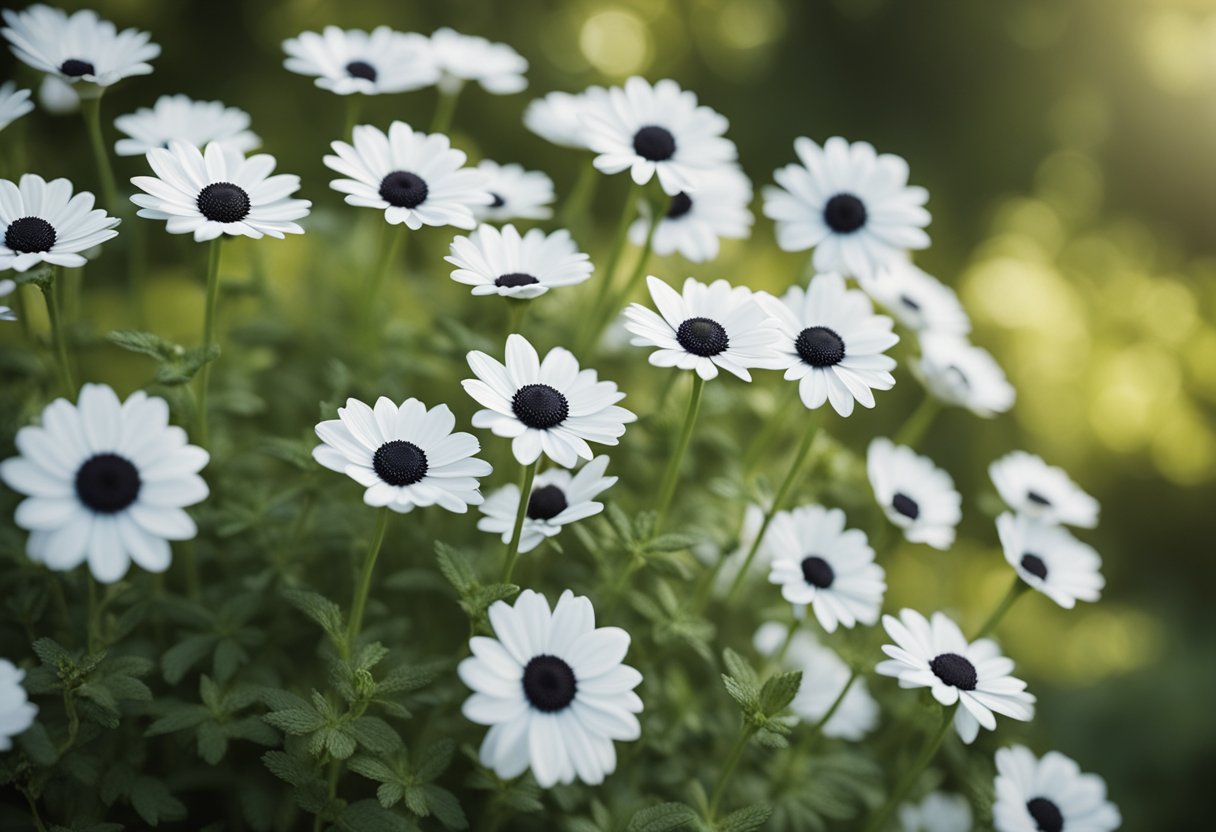
As a responsible gardener, I believe it is important to consider the conservation status of the plants I choose to grow. Here are some of the white flowers with black centers that are endangered species:
Endangered Species
- Black Bat Flower (Tacca chantrieri): This unique flower with its black bat-like wings and white center is native to Southeast Asia. It is currently listed as an endangered species due to habitat loss and overharvesting for medicinal purposes.
- Ghost Orchid (Dendrophylax lindenii): This rare orchid is known for its white petals and black center. It is found in the swamps of Florida and Cuba and is currently listed as an endangered species due to habitat destruction and illegal collection.
- White Fringeless Orchid (Platanthera integrilabia): This orchid is found in the southeastern United States and is known for its white flowers with a black center. It is currently listed as an endangered species due to habitat loss and fragmentation.
- White Lady Slipper (Cypripedium candidum): This orchid is found in the northeastern United States and is known for its white flowers with a black center. It is currently listed as an endangered species due to habitat loss, illegal collection, and habitat destruction.
As gardeners, it is our responsibility to help conserve these endangered species by not collecting them from the wild and only purchasing them from reputable nurseries that propagate them responsibly.
Photography Tips for White Flowers with Black Centers
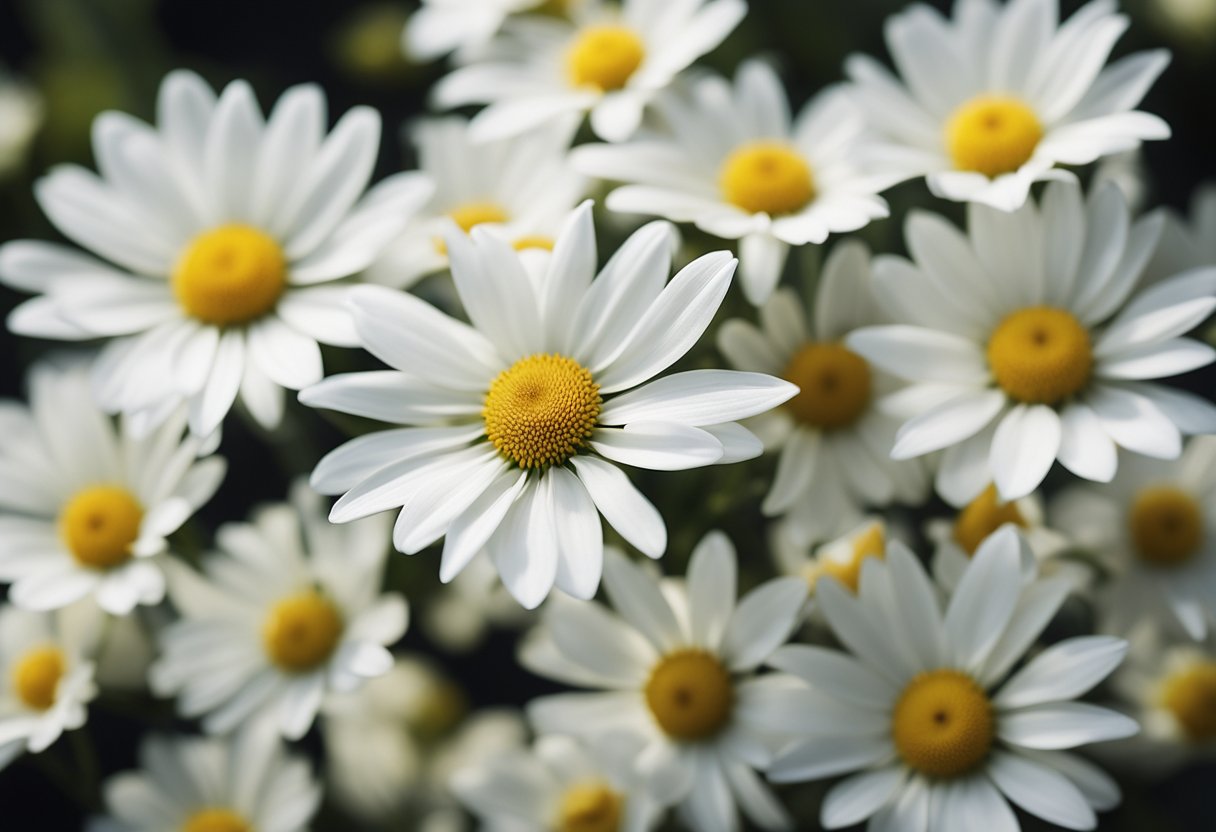
Lighting
When photographing white flowers with black centers, lighting is crucial. It is important to avoid harsh, direct sunlight as it can create unwanted shadows and highlights. Instead, opt for soft, diffused lighting such as on an overcast day or in the early morning or late afternoon when the sun is lower in the sky.
If you are shooting indoors, try using a softbox or diffuser to create a similar effect. This will help to create a more even lighting across the flower and reduce any harsh shadows.
Composition
Composition is also an important factor when photographing white flowers with black centers. Try to avoid centering the flower in the frame, instead, use the rule of thirds to create a more dynamic image.
Experiment with different angles and perspectives, such as shooting from above or below the flower. This can help to create a more interesting composition and highlight the unique features of the flower.
Finally, consider the background of your image. A cluttered or distracting background can take away from the beauty of the flower. Look for a simple, neutral background or use a shallow depth of field to blur the background and create a more dramatic image.
Remember, the most important thing when photographing white flowers with black centers is to have fun and experiment with different techniques. With a little practice and patience, you can capture stunning images of these beautiful flowers.
Buying Guide for White Flowers with Black Centers
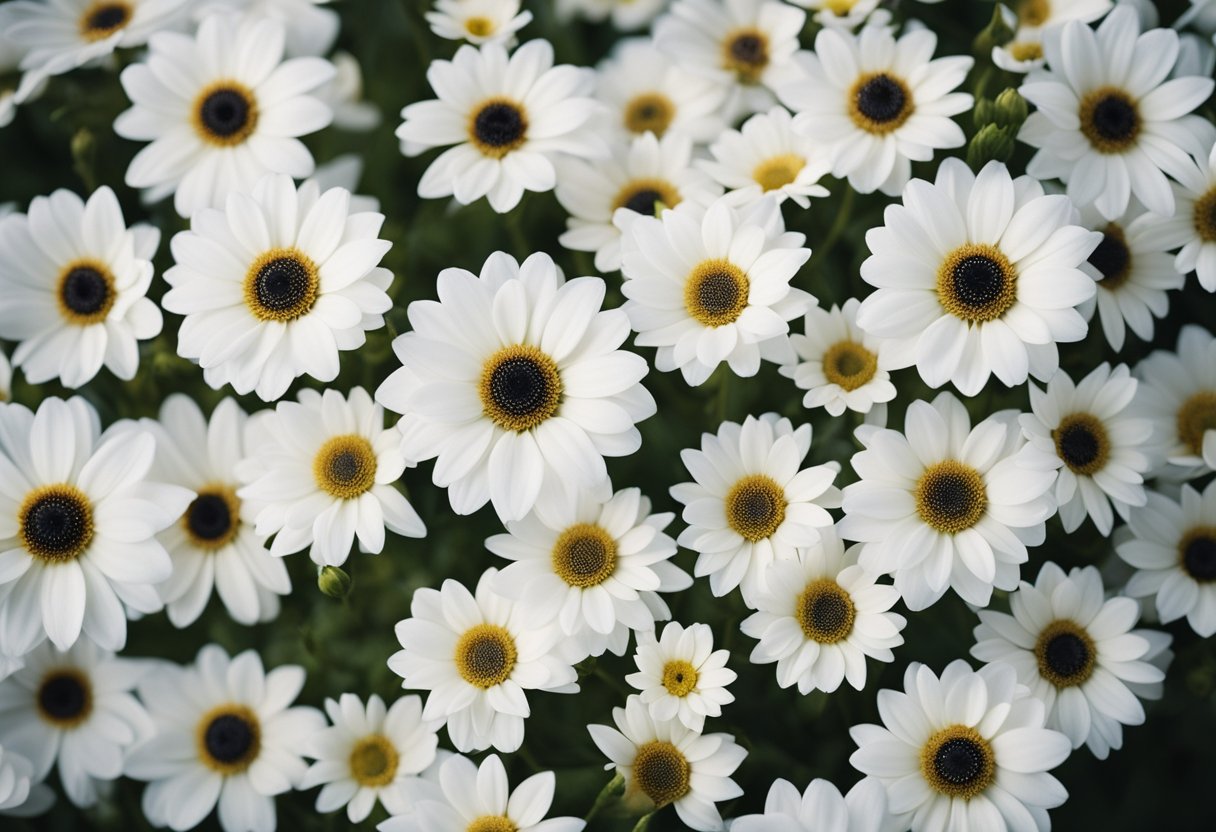
When shopping for white flowers with black centers, there are a few things to consider to ensure you get the best quality and value for your money. Here are some tips on where to buy these beautiful flowers.
Nurseries
Local nurseries are a great place to start when looking for white flowers with black centers. They often carry a wide variety of flowers, including those with black centers, and the staff can offer advice on which ones will work best for your garden.
When visiting a nursery, be sure to inspect the plants carefully before purchasing. Look for healthy foliage and stems, and avoid plants with yellow or brown leaves or signs of insect damage. Also, make sure the plants are labeled correctly so you know exactly what you’re buying.
Online Shops
Online shops are a convenient option for buying white flowers with black centers, especially if you’re looking for a specific variety that may not be available locally. Many online shops specialize in flowers and plants and offer a wider selection than local nurseries.
When shopping online, be sure to read reviews of the seller and check their return policy before making a purchase. Look for sellers with a good reputation and positive feedback from other customers. Also, be aware of shipping costs and delivery times, as these can vary widely between sellers.
Whether you choose to shop at a local nursery or online, be sure to do your research and inspect the plants carefully to ensure you get the best quality and value for your money. With the right care and attention, your white flowers with black centers will add beauty and interest to your garden for years to come.
Frequently Asked Questions
What is the common name for white flowers that feature a distinctive black center?
The most common name for white flowers with a black center is the black-eyed Susan. However, there are other flowers that also feature a similar appearance, such as anemones and daisies.
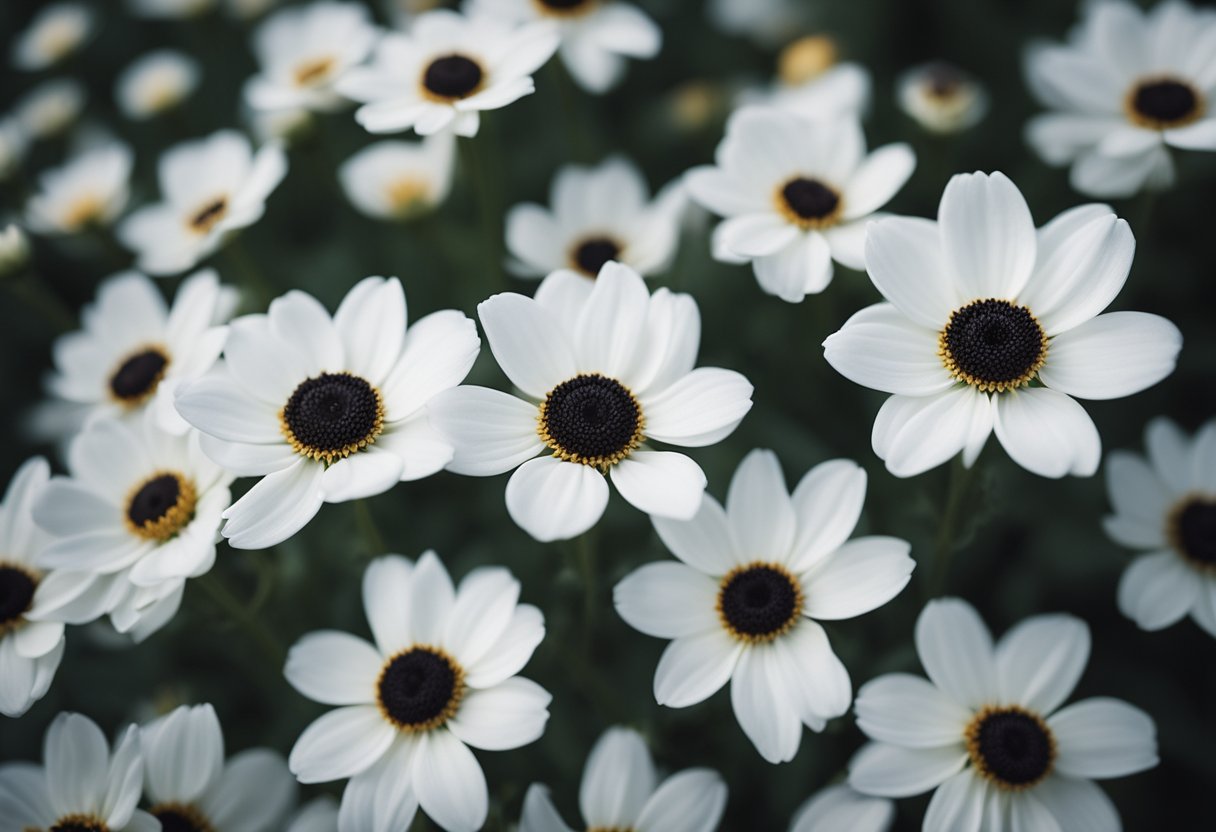
Which season is best for planting white anemones with black centers?
White anemones with black centers are best planted in the fall, around September or October. This will allow the flowers to establish their roots before the winter months.
How can you create an elegant bouquet using white flowers with black centers?
To create an elegant bouquet using white flowers with black centers, you can pair them with dark green foliage or other flowers in similar colors, such as deep purple or burgundy. This will create a striking and sophisticated look.
Are there any black flowers that can be paired with white blooms for a monochromatic garden theme?
Yes, there are several black flowers that can be paired with white blooms for a monochromatic garden theme. Some examples include black dahlias, black pansies, and black petunias.
What care instructions are recommended for maintaining the vibrancy of white daisies with black centers?
White daisies with black centers should be planted in well-draining soil and watered regularly. Deadheading the flowers can also help to maintain their vibrancy and encourage new blooms.
Can you suggest some other flowers that resemble the black-eyed anemone in appearance?
Other flowers that resemble the black-eyed anemone in appearance include the Japanese anemone, the poppy anemone, and the wood anemone. These flowers feature similar white petals with a dark center, making them a great addition to any garden or bouquet.